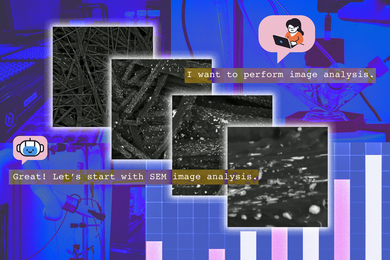 Under Development
Under Development
Machine-learning models can speed up the discovery of new materials by making predictions and suggesting experiments. But most models today only consider a few specific types of data or variables. Compare that with human scientists, who work in a collaborative environment and consider experimental results, the broader scientific literature, imaging and structural analysis, personal experience or intuition, and input from colleagues and peer reviewers.
Now, MIT researchers have developed a method for optimizing materials recipes and planning experiments that incorporates information from diverse sources like insights from the literature, chemical compositions, microstructural images, and more. The approach is part of a new platform, named Copilot for Real-world Experimental Scientists (CRESt), that also uses robotic equipment for high-throughput materials testing, the results of which are fed back into large multimodal models to further optimize materials recipes.
Human researchers can converse with the system in natural language, with no coding required, and the system makes its own observations and hypotheses along the way. Cameras and visual language models also allow the system to monitor experiments, detect issues, and suggest corrections.
“In the field of AI for science, the key is designing new experiments,” says Ju Li, School of Engineering Carl Richard Soderberg Professor of Power Engineering. “We use multimodal feedback — for example information from previous literature on how palladium behaved in fuel cells at this temperature, and human feedback — to complement experimental data and design new experiments. We also use robots to synthesize and characterize the material’s structure and to test performance.”
The system is described in a paper published in Nature. The researchers used CRESt to explore more than 900 chemistries and conduct 3,500 electrochemical tests, leading to the discovery of a catalyst material that delivered record power density in a fuel cell that runs on formate salt to produce electricity.
Joining Li on the paper as first authors are PhD student Zhen Zhang, Zhichu Ren PhD ’24, PhD student Chia-Wei Hsu, and postdoc Weibin Chen. Their coauthors are MIT Assistant Professor Iwnetim Abate; Associate Professor Pulkit Agrawal; JR East Professor of Engineering Yang Shao-Horn; MIT.nano researcher Aubrey Penn; Zhang-Wei Hong PhD ’25, Hongbin Xu PhD ’25; Daniel Zheng PhD ’25; MIT graduate students Shuhan Miao and Hugh Smith; MIT postdocs Yimeng Huang, Weiyin Chen, Yungsheng Tian, Yifan Gao, and Yaoshen Niu; former MIT postdoc Sipei Li; and collaborators including Chi-Feng Lee, Yu-Cheng Shao, Hsiao-Tsu Wang, and Ying-Rui Lu.
Here’s How It Works:
1. Refer a Friend: Share the name and contact details of anyone who might benefit from our innovative web solutions.
2. They Sign a Deal: When your referral becomes a client and completes a $5,000+ contract with us, you get rewarded.
3. Get Paid: Receive $1,000 in cash as a thank you for your referral after final payment has been received from the referred client!
It’s that simple. Help your friends get the best in web design and development, and earn big while doing it. Start referring today and watch your rewards grow!
*Subject to IRS income tax rules and regulations
©2013-2025 | All rights reserved.